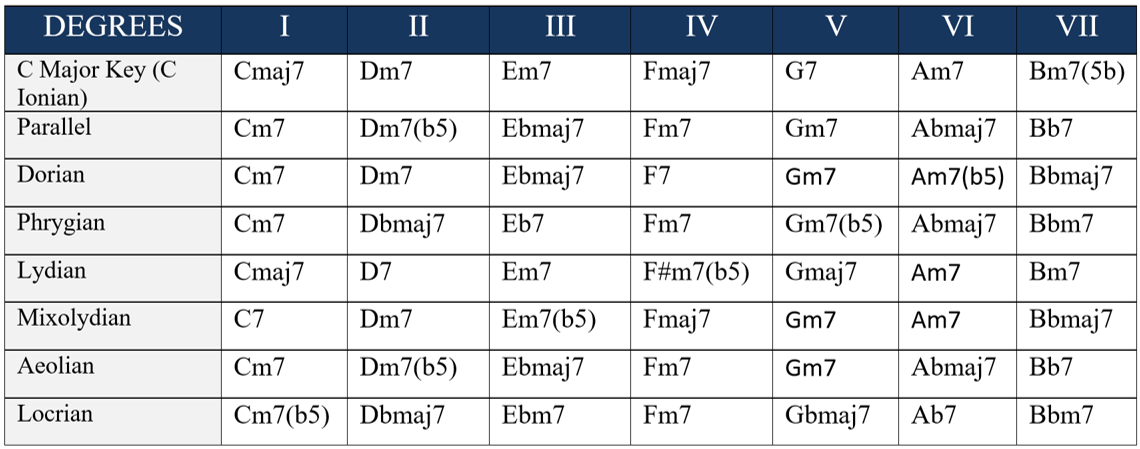As the name implies, Borrowed Chords are chords borrowed from other modes. These modes can be a music mode or the Parallel mode.
Most of the time, Borrowed Chords come from the parallel mode. For this reason, many authors classify Borrowed Chords as borrowing only from the parallel mode. Our definition here, however, will be more comprehensive than that.
Example of borrowed chord
Before we continue, let’s see an example of a Borrowed Chord: let’s say a song is in the key of C major. If, at some point in the song, the Ebmaj7 chord appears, we quickly identify that it is not part of the key of C major but of the key of C minor. As C minor is the parallel of C major, we conclude that Ebmaj7 is a Borrowed Chord of the parallel mode.
Borrowed Chords are transient chords; they appear in the song suddenly and, soon after, the song resumes its tonal harmony. It is rare to have a Borrowed Chord accompanied by a cadence, because, in this case, we would be characterizing a modulation. Notice the difference: modulations are small transitions in tonality. Borrowed Chords do not constitute a change of tonality; they are just borrowed and transient chords. Having understood this difference, we can proceed.
Considering all modes, there are many options of Borrowed Chords to use in songs. See the chords of the keys below in all available modes for the C tone:

From the point of view of extension notes, it is very common to replace, in the parallel mode, the Im7 and IVm7 degrees by the Im6 and IVm6 degrees due to the pleasant sound produced.
You must also pay attention to the Vm7 chord, because in some cases, it is not a Borrowed Chord but a IIm7, creating a modulation to the fourth degree. Example: Gm7 – C7 – F.
Very well, you may have noticed that there are a lot of details, so you need to work on each one calmly.
Now that the concept of Borrowed Chords is already very solid, try to train a little improvisation on top of those chords. Let’s look at some songs that contain Borrowed Chords to make you believe that this really exists and is actually used!
How to improvise over Borrowed Chords
Improvising over Borrowed Chords is simple, just identify where the Borrowed Chord came from and play the scale of that mode over the chord. In theory it is easy, but in practice you must be thinking that it is difficult, because we need to identify very quickly what was the borrowed mode to know which tonality or scale to use. This is actually true. This is why it is useful to know which are the most widely used Borrowed Chords, so that you can memorize these degrees and automatically know what to use in these situations. Or you can just remember the tips we already gave in the article “Modal Music” about using the Dorian and Lydian scales.
All of this will help to reduce your surprises when improvising and increase your musical baggage. The more practice and experience you have, the faster your reflexes will get.
Examples of songs
Here are some examples of songs that use Borrowed Chords:
- Meu Erro (Herbert Vianna): A major tonality. Borrowed Chord = Dm. See on Youtube.
In this song in A major, we clearly have a single chord that is not part of the key of A: the Dm chord. In the key of A major, D is the IV degree major, not minor (IVm). The Dm chord is present in the key of A minor, so Dm is a Borrowed Chord of the parallel mode.
- Nos bailes da vida (Milton Nascimento): D major tonality. Borrowed Chord = C. See on Youtube.
In this song in D major, the C chord should be C#m7(b5) (VIIm7b5). However, C major appears in the song, acting as a Borrowed Chord of the parallel mode, as it exists in the key of D minor (it is the lowered seventh degree bVII). This song still has other interesting characteristics, like cadences II – V – I for the tonic and first degree with passing notes. This last characteristic appears in the D4 chord (where the fourth is an avoid note. The D4 chord appears just before the D chord, emphasizing that this fourth is just a passing note).
Go to: How to modulate
Back to: Module 10
